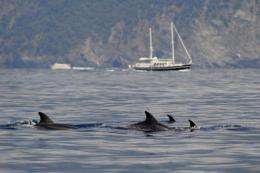Tracking dolphins in the Gulf of Genoa: a researcher's joy

"There they are," murmurs Fulvio Fossa, smiling as he points to a herd of dolphins off of Cinque Terre in northwestern Italy.
Two or three times a week, come wind or rain, Fossa heads out in his rubber dinghy in search of his marine friends, cataloguing them, photographing them and observing them for nearby Genoa's aquarium, among the most popular in Europe.
Whipping out his camera, Fossa begins taking snaps of the more than a dozen bottlenose dolphins, telling AFP they are a herd of mothers with their young.
One of the adults approaches the vessel for a better look at the noisy intruders.
"Females are very protective. When a boat approaches, they shield their offspring," said Fossa, a 35-year-old University of Genoa graduate with sun-bleached blond hair.
He and two colleagues have been studying dolphin behaviour in the Gulf of Genoa since 2006.
"Adult dolphins can reach three to three and a half meters (10 to 11.5 feet) and their life expectancy is about 45 years in captivity and about ten less in the wild," he said.
The researchers -- along with others in the Mediterranean region -- have discovered that the dolphins sleep with one eye closed and only half of their brains resting at a time.
As it sleeps, "the dolphin continues to swim in circular, regular motions as the eye corresponding to the sleeping part of the brain remains shut," Fossa said.
Dolphins' interaction with humans is also a subject of extensive research.
Humans are their worst enemies, polluting their environment with chemicals and noise and depleting their food resources.
Meanwhile fishermen are leery of dolphins because they have the same prey, such as mackerel, sea bream, whiting, goatfish and cuttlefish, Fossa said.
"On top of that, dolphins loot the fishermen's nets, and that's where the love-hate relationship between dolphins and humans comes from," he added.
"Apparently, they respect borders. Those around Corsica stay in the area south of France and do not mix with those of the Gulf of Genoa or along the Tuscan coast," Fossa said.
Thanks to the hundreds of pictures he takes, Fossa can track the movements of the dolphins, some of which are so familiar to him that he has given them names, such as Mario and Gashed Fin.
In fact, more than the snout, it is the dolphin's dorsal fin -- with its scars and marks -- that serves as a calling card for researchers to tell one dolphin from another.
"Dolphins seem identical, but if you take a closer look, you can see their fins are very different, either in shape or in terms of the scars they have," said Guido Gnone, the head of the research project based at Genoa's aquarium.
Fossa sends his pictures to Gnone, who organises them in a photo archive, allowing the researchers to follow the dolphins' movements over several years.
They now have files on 244 specimens.
As two dolphins splashed about in an enormous tank in front of enthralled young visitors, Gnone said his main aim was to "fill gaps in our knowledge about dolphins."
Dolphin lovers are directed to the Cetacean Observation Centre (CETUS) at Viareggio, a Tuscan village about 100 kilometers (60 miles) southeast of Genoa, where they can sign up to accompany researchers on their sorties (www.cetusresearch.org).
(c) 2010 AFP













